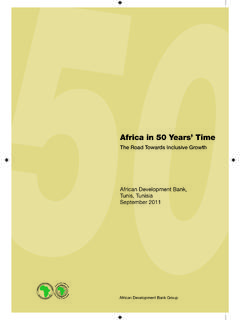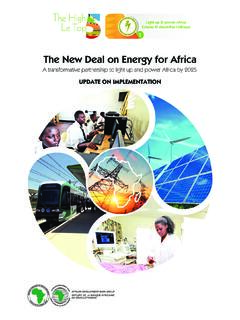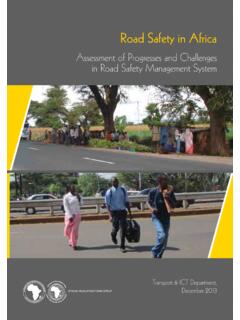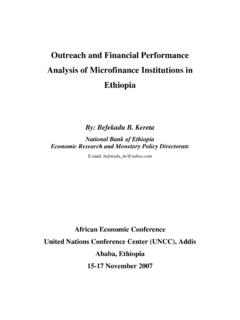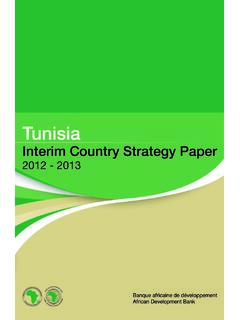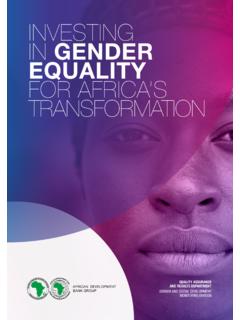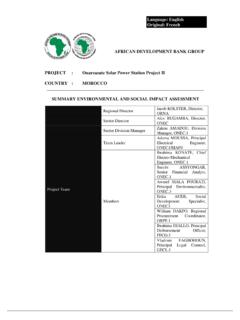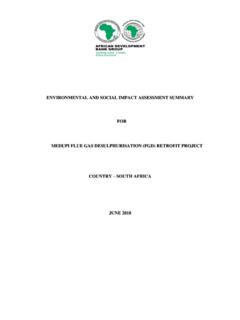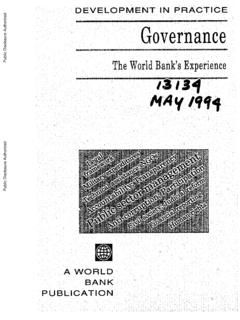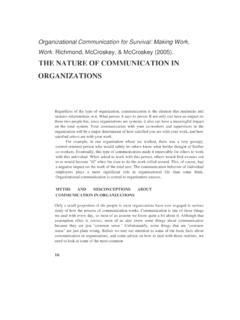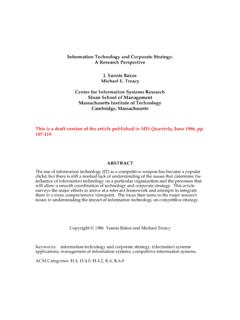Transcription of AFRICAN DEVELOPMENT BANK GROUP
1 AFRICAN DEVELOPMENT bank GROUP Review of the bank s ICT Operations Strategy & Action Plan for the Medium Term 2012-2014 OPERATIONAL POLICIES DEPARTMENT (ORPC) TRANSPORT AND ICT DEPARTMENT (OITC) May 2012 Review of the bank s ICT Operations Strategy & Action Plan for the Medium Term 2012-2014 Members of the Task Team Marcellin NDONG NTAH, Chief DEVELOPMENT Policy Economist, Salieu JACK, Chief Information and Telecom. Engineer, ICT4D Ali YAHIAOUI, Chief ICT Officer, ICT4D Richard Anthony CLAUDET, Chief Investment Officer, Corbin Michel GUEDEGBE, Chief Education Analyst, Enock YONAZI, Principal Telecommunication Engineer, ICT4D Karim MHIRSI, Principal Investment Officer, Koua Louis KOUAKOU, Senior Statistician, Hee-Sik KIM, Research Economist, Augusto Q.
2 MAQUENGO, Portfolio Data Analyst, Table of Contents List of Abbreviations .. i Executive Summary .. ii 1. Introduction .. 1 2. Review of the Implementation of the ICT Operations Strategy .. 1 Overview ..1 Implementation of Pillar 1: Regional and National ICT Infrastructure ..1 Implementation of Pillar 2 : Policy and Regulatory Frameworks ..4 Implementation of Cross-cutting Issues ..6 Assessment of Financing and Resource Mobilization ..8 Review of Institutional Arrangements and Staffing ..9 3. Trends and Investment Opportunities in ICT in the Medium Term .. 10 Trends in the Mobile Industry .. 10 Trends in Internet Broadband .. 11 Trends in ICT Sector Investment.
3 12 DEVELOPMENT Assistance in the ICT Sector .. 13 Opportunities for the bank .. 13 4. bank GROUP Action Plan for the Medium Term .. 15 Overview .. 15 Focus Area 1 Regional/national ICT infrastructure .. 16 Focus Area 2 - Policy and Regulatory Frameworks .. 17 Focus Area 3 - ICT Applications .. 17 Knowledge Management and Sharing .. 18 Financing Instruments .. 18 Staffing and Institutional Arrangements .. 19 Partnerships and Coordination .. 20 5. Conclusions and Recommendation .. 20 Annex Africa Fiber Map .. I Annex - Key Phases in Africa s Bandwidth History .. II Annex II - Indicative Pipeline Projects .. III Annex III - Results-Based Logical Framework for 2012-2014.
4 IV Annex IV. Profile for the New Staff in the ICT Division .. VII i List of Abbreviations ACE Africa Coast to Europe ADF AFRICAN DEVELOPMENT Fund ADB AFRICAN DEVELOPMENT bank AU AFRICAN Union CAB Central AFRICAN Backbone CAETIC CDMA Centre Africain d Excellence en TIC Code Division Multiple Access CEMAC Communaut conomique et Mon taire de l'Afrique Centrale CNS/ATM communication , Navigation, Surveillance / Air Trafic Management DFS DSL Detailed Feasibility Study Digital Subscriber Lines EAC East AFRICAN Community EAC-BIN East AFRICAN Community Backbone Infrastructure Network ECA Economic Commission for Africa ESIAS Environment and Social Impact Assessment Study EASSy East Africa Submarine Cable System ECOWAN ECOWAS Wide Area Network ECOWAS EV-DO Economic Community for West AFRICAN States Evolution.
5 Data Optimized GDP Gross Domestic Product HEST Higher Education Science and Technology ICT Information and Communications Technologies IDRC International DEVELOPMENT Research Centre IPPF Infrastructure Project Preparation Facility ITES Information Technology Enabled Services ITU International Telecommunications Union LIC Low Income Countries LION Lower Indian Ocean Network MDB Multilateral DEVELOPMENT Banks MIC Middle Income Countries NEPAD New Partnership for AFRICAN DEVELOPMENT NREN National Research and Education Network OECD Organization for Economic Cooperation and DEVELOPMENT OINF Infrastructure Department OITC Transport and ICT Department OIVP Infrastructure, Private Sector and Regional Integration Vice Presidency ORPC Operational Policies Department PIDA Programme for Infrastructure DEVELOPMENT in Africa RCIP Regional Communications Infrastructure Programme RECs Regional Economic Communities RMC Regional Member Countries RREN Regional Research and Education Network SADC Southern AFRICAN DEVELOPMENT Community SMCC Senior Management Coordination Committee TEAMs The East AFRICAN Marine System WACS West Africa Cable System ii Executive Summary Africa s ICT sector has seen unprecedented growth in recent years.
6 The private sector has invested close to USD 50 billion in the last decade, with a focus on mobile and related applications, and more recently in international submarine cables. Mobile density in the continent jumped from 20% (in terms of the number of SIM cards sold per 100 inhabitants) in 2005 to around 65% in 2011. Recent completion of undersea cables has tripled available bandwidth. However, the rollout of ICT infrastructure, in particular access to the Internet is uneven (Internet penetration is about in 2011) and many underserved countries and areas remain. In addition the lack of regional and national backbone infrastructure is a stumbling block towards the DEVELOPMENT of broadband Internet.
7 The promotion of ICT in Africa still requires investing billions of USD. The short term objectives of the ICT Strategy which was approved in October 2008 were to support the DEVELOPMENT of regional and national broadband infrastructure and to create an enabling policy and regulatory environment that would attract private investment and encourage public-private partnerships. During the review period (2008-2011), the bank GROUP has approved about USD 212 million in loans and grants for the DEVELOPMENT of regional infrastructure projects, of which USD 170 million through the private sector lending window1 and USD 42 million through the public sector financing window.
8 It has promoted policy dialogue on ICT issues and supported training efforts and the sharing of experiences in mobile technologies, digital broadcasting and e-security. The bank s interventions in capacity building have focused on establishing ICT centers of excellence in support of Connect Africa Summit commitments. The publication of the AFRICAN Economic Outlook of 2008 focusing on ICT raised the bank s profile on the issue. However, work remains to be done in expanding ICT activities. Inadequate staffing for ICT activities is one of the main challenges to expanding the bank s ICT portfolio. The bank GROUP needs to leverage the public-private partnership space that is opening up for delivery of ICT infrastructure and services.
9 To this end, it will work to strengthen the existing interaction between its ICT interventions in the public and the private sectors. The absence of a Manager for ICT activities and general lack of in-house expertise in ICT regulations and PPPs are key impediments. Moreover, the lack of flexible funding arrangements dedicated to ICT prevents the timely launching of catalytic projects, advisory services and other opportunities for the promotion of the bank s enhanced lending in the sector. Looking ahead, the bank needs to focus on: (i) extending ICT infrastructure to underserved areas and expanding regional/national ICT broadband infrastructure; (ii) creating enabling policy/regulatory environment to leverage private investment and forging PPPs for improved and affordable connectivity; and (iii) providing support for RMCs to scale up their ICT applications in all sectors to transform public service delivery and regional integration.
10 The bank should firm up its ICT organizational structure by appointing a Manager, recruiting adequate staff, and creating more synergies between private lending and public non-financing and financing operations in the sector. With regard to financing, Management opts for a financing mechanism that relies on the existing bank s Trust Funds and external resources with the aim to financing opportunistic and scalable innovative projects, capacity building and advisory services that catalyze further investment. 1 It should be noted that the bank had approved one year before the review period, in 2007, two major operations funded through its private sector window and amounted to USD 65 million.

